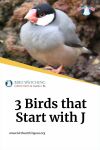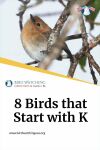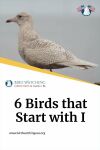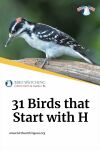
Introduction
Bird lovers, unite! Have you ever wondered about birds that begin with the letter J? I always had, especially if any of them existed among the most common birds in the USA and Canada! I was surprised to find out that there are only 3 out of 750 such birds. Isn’t that shocking - only 0.4%?
The names of these birds are courtesy of the information provided by eBirds.com. It’s a wonderful platform where bird lovers like us can contribute to the online data of birds, as we watch them on our birdwatching journey. So I’m thankful for the data that I’ve retrieved from them - it was super fast and easy!
Here’s a quick overview of the most common birds starting with J in the USA and Canada.
| Juniper Titmouse | 0.18% |
|---|---|
| Java Sparrow | 0.04% |
| Japanese Bush Warbler | 0.02% |
Now that you know their names, let’s look at their pictures along with tips on how to find them!
1. Juniper Titmouse

We have Juniper Titmouse as #1 on this list!
Thanks to the bird feeder in my backyard, I had an up-close and personal experience with the Juniper Titmouse! If you want to attract a breeding pair, I’d also recommend you set up a nest box! Also, don’t forget to guard the box - you wouldn’t want any predators getting near your feathered friends, would you?
Do you wish to see these birds in their natural woodland habitat instead? Try heading to the woods that have juniper and pinyon. Your best bet would be to go out between the months of March and May. The Juniper Titmouse loves to sit on a branch and sing its heart out first thing in the morning!
Since they don’t dwell on extreme heights, you can also find them wandering around the outer branches of trees, bushes, and shrubs. You can find them easily at eye-level, foraging on all types of insects. These birds also eat seeds, nuts, and even small fruits such as berries. And look for another of their favorite positions - they simply love to hang upside down!
All in all, you can find these birds easily. They’re almost always chattering, and that is what made me notice them when I was in the woodlands.
fun fact
hissing sound
The female Juniper Titmouse never likes to leave her nest. She would make a hissing sound if she feels like she is being forced to abandon her eggs.
If you’re looking for a nesting box, consider getting this one .
Precision Pet Single Nesting Box
A simple wooden nesting box that's around 33.2 cm in height, and 4.5 cm in length.
2. Java Sparrow

Up next on #2 we have the Java Sparrow! Its lovely grey-feathered body produces high contrast with its black head and pinkish beak. This sparrow is also known as the ‘java finch’, ‘java rice’ bird, or the ‘paddy’ bird. Another distinguished quality of its appearance is the prominent white patch on its ears.
So where and how can you find the Java Sparrow or Java Finch? You can find them foraging easily in both countryside and city areas. But since these birds are extremely small, you might need to increase and sharpen your focus. Originally, these birds are from the islands of Java and Bali in Indonesia. So it comes as no surprise that these sparrows love to explore rice fields to satisfy their tummies. But apart from that, if you keep these birds as pets, they love to feed on seed-mix of any type!
I have had a few Java finches as pets. And they are quite playful creatures. Make sure you get them tiny toys and bird accessories like ladders and swings so they’re always having quality time! You can also get nesting boxes for them, though they’re necessary only when you want them to breed. It’s also fine if you want to keep same-sex pairs as these birds aren’t prone to fighting.
Also, pay close attention to its chirping and trilling sounds. Java Sparrows also make wonderful pets, so if you’ve been looking forward to getting some feathered friends for yourself, these are the ones!
fun fact
lost eggs
Did you know that lost eggs can take a toll on the female java finch? She can try to replace them by laying more eggs and that could be harmful to her health. To avoid this from happening, you can place fake or toy eggs inside!
3. Japanese Bush Warbler

The final one on this list is the Japanese Bush Warbler!
These tiny birds are difficult to spot because their color and texture blends into the environment quite well. Their feathers have a greenish-brown touch to them, so it was so difficult for me to see these birds against a backdrop of wood and leaves. You can find them easily in dense forests and thickets and similar environments. Since they’re quite small themselves, they love to eat tiny insects, along with some worms and also a couple of fruits and berries from time to time.
It’s easiest to spot them when they are singing, because the males usually sit on an exposed branch to start the performance. Their song usually begins with a very long note. Notice if you can hear any warbling voice and calls and let them guide you. They sound like they’re repeating the phrase, “uuuu-gisu” over and over again!
fun fact
Short life span
The Japanese Bush Warbler has quite a short life span of between 2 to 5 years.
Conclusion
So that’s all for the three most common birds starting with K in the USA and Canada. Have you seen any of the above birds and did any of them make it to your list of favorites? Don’t forget to keep our birdwatching tips in mind when you’re getting ready to see these beautiful feathered friends.
Also, read this post if you want to learn about the most common birds that start with the letter k !
8 Birds that Start with K
There are around 750 most common birds in the USA and Canada. Out of these, only 8 of them start with the letter K. Here's the full list for every birdwatcher!

By David A. Swanson
Bird Watching USA
My name is David and I'm the the founder of Bird Watching USA! I started Bird Watching with My father-in-law many years ago, and I've become an addict to watching these beautiful creatures. I've learnt so much over about bird watching over the years that I want to share with the world everything I know about them!

David A. Swanson
Bird Watching USA
My name is David and I'm the the founder of Bird Watching USA! I started Bird Watching with My father-in-law many years ago, and I've become an addict to watching these beautiful creatures. I've learnt so much over about bird watching over the years that I want to share with the world everything I know about them!









